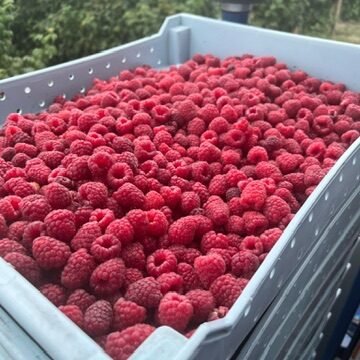This post was sponsored by American Frozen Food Institute, but the opinions are my own.
Frozen Food: Nature’s Pause Button
Fact: Most Americans do not meet the Dietary Guidelines for fruits and vegetables. Frozen foods can make reaching your recommended intake possible (and easier).
My latest book encourages consumers to waste less food. Freezing is a food waste solution. It is also a preferred method of food preservation because it maintains the integrity, nutritional value and freshness of food. Frozen foods offer year-round quality and availability. Furthermore, there are indications that frozen foods equivalent in nutrients to fresh and local food. Think of the freezer as “nature’s pause button.”
Delicious in the field, but grown specifically for your favorite grocer’s freezer.
Where do frozen raspberries come from?
I was invited by American Frozen Food Institute (along with 3 other media nutritionists) to attend the Washington Red Raspberry Commission Harvest Tour in Lyndon, Washington.
I love the opportunity to see where our food comes from, with my own eyes, and share the story with you. Not to mention how wonderful it is to see so many beautiful parts of our country and meet the wonderful people who grow our food. There are so many coordinated steps to get our food to the grocery store. I remain incredibly grateful for the work of the people who grow, tend, harvest, harvest and process our food.

Washington state blueberry fields.
Raspberries – Grown for frozen food
Fun fact: Washington state produces about 90% of the nation’s frozen red raspberry crop. This area is growing over £60 million raspberries annually on 9,600 acres!
I visited two farms. Enfield Farms grows, harvests and freezes, on site. We had the opportunity to tour their fields and facilities. We also visited Markwell Farms where we rode in a combine and see how the berries are picked.
The berries are planted on a raised mound in a manner specially designed for mechanical harvesting. Berries grown for the frozen food industry must taste delicious, but also remain intact throughout the picking and freezing process. They are picked at the peak of ripening, locking in nutrition and flavor.

Greenhouses where they grow and test new varieties of blueberries that will be delicious but also last until freezing.
Berry structure and flavor
Cultivating and cultivating this delicate fruit requires constant research in the greenhouse. At some point in your life you may have enjoyed fresh raspberries that, while delicious, split into tiny balls in your hands. This type of berry may not work as well for scale freezing. Scientists and farmers are constantly working to ensure they have the best plants that produce the best berries. A lot of work and testing goes into breeding plants and running the greenhouse at Enfield Farms. These berries should taste good and keep until frozen.
The Harvest
While the entire blueberry operation (growing, rearing) goes on year-round, the summer harvest season lasts only a few, intense weeks. When you have millions of pounds of berries to pick, you need machinery!

Blueberry plants use a wire trellis system to support the canes on which the berries grow. The rows are specifically spaced ten feet apart to accommodate the machines. Combine harvesters drive carefully between the rows.


Harvesters carefully lower each row and shake the berries from the plants, sending them onto a conveyor belt that drops them into boxes. One machine can harvest 20 to 25 acres/day.

The first inspection of the berries is done by hand right from the harvester. A picker separates any leaves, stems or unripe berries from the boxes.
Farm to Freezer: The Harvest Plant
From the field, the crates from the combines are delivered to the processing plant. There, they cool quickly, before going through the freezing and packaging process. Amazing!

Berries are frozen and packed in less than 24 hours from picking. TThe quick freezing process only takes 13 minutes! The gentle flash-freezing process preserves the flavor and nutritional integrity of the fruit.

At the processing plant: Frozen raspberries ride the conveyor belt and are ready for packaging.
Friends with Benefits – Frozen food.
I often say, “the freezer is your friend” for reducing food waste. I love the low waste of frozen foods. However, “frozen products” are sometimes seen as inferior compared to fresh products. Not like that!
Frozen is just as nutritious, and sometimes even more nutritious, because of its short wait from harvest to freezing. Freezing prevents nutrients from falling into produce after harvest. (Also protects protein, vitamins A and D, or other nutrients in meat, seafood, and poultry.)
Quick facts:
- Washington state produces about 90% of the nation’s frozen red raspberry crop. Combine harvesters in Whatcom County Washington 60 million pounds of raspberries a year.
- Every September, they harvest about 300-400 thousand pounds of raspberries per day. They are quickly transported to on-site facilities where the berries are frozen and packed.
- The highest quality berries are selected for the freezing process. Freezing preserves macro- and micronutrients and locks in nutrition.
- Frozen raspberries are a low waste product. You will be happy to know that 99% of the product is used. Imperfect berries are used for juices and purees (for canning or cooking applications).
- Frozen berries have so much culinary applications: Sauces (sweet or spicy), smoothies, in oatmeal or overnight oats, cheesecake and other desserts.

I hope you enjoyed this look into the frozen blueberry industry and offered some insight into the work and skill it takes to grow our food and the benefits of frozen food!

RD friends riding the combine at Markwell Farms
Questions? Add a comment!


